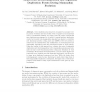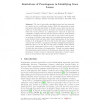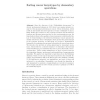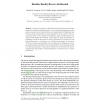98
Voted
RECOMB
2008
Springer
16 years 1 months ago
2008
Springer
Gene duplication has long been recognized as a major force in genome evolution and has recently been recognized as an important source of individual variation. For many years the o...
99
Voted
RECOMB
2008
Springer
16 years 1 months ago
2008
Springer
The loss of previously established genes has been proposed as a major force in evolutionary change. While the sequencing of many new species offers the opportunity to identify case...
117
click to vote
RECOMB
2008
Springer
16 years 1 months ago
2008
Springer
Since the discovery of the "Philadelphia chromosome" in chronic myelogenous leukemia in 1960, there is an ongoing intensive research of chromosomal aberrations in cancer....
108
Voted
RECOMB
2008
Springer
16 years 1 months ago
2008
Springer
We study the problem of transforming a multichromosomal genome into another using Double-Cut-and-Join (DCJ) operations. We introduce the notion of DCJ scenario that does not break ...
88
Voted
RECOMB
2008
Springer
16 years 1 months ago
2008
Springer
93
Voted
RECOMB
2008
Springer
16 years 1 months ago
2008
Springer
Abstract. Contemporary inferences about evolution occasionally involve analyzing infinitely large feature spaces, requiring specific algorithmic techniques. We consider parsimony a...
105
Voted
RECOMB
2008
Springer
16 years 1 months ago
2008
Springer
In the past years, many combinatorial arguments have been made to support the theory that mammalian genome rearrangement scenarios rely heavily on breakpoint reuse. Different model...
110
Voted
RECOMB
2008
Springer
16 years 1 months ago
2008
Springer
Abstract. As data about genomic architecture accumulates, genomic rearrangements have attracted increasing attention. One of the main rearrangement mechanisms, inversions (also cal...
104
click to vote
RECOMB
2008
Springer
16 years 1 months ago
2008
Springer
Abstract. Whole genome doubling (WGD), a frequent occurrence during the evolution of the angiopsperms, complicates ancestral gene order reconstruction due to the multiplicity of so...
113
click to vote
RECOMB
2008
Springer
16 years 1 months ago
2008
Springer
Following various genetic mapping techniques conducted on different segregating populations, one or more genetic maps are obtained for a given species. However, recombination analy...




